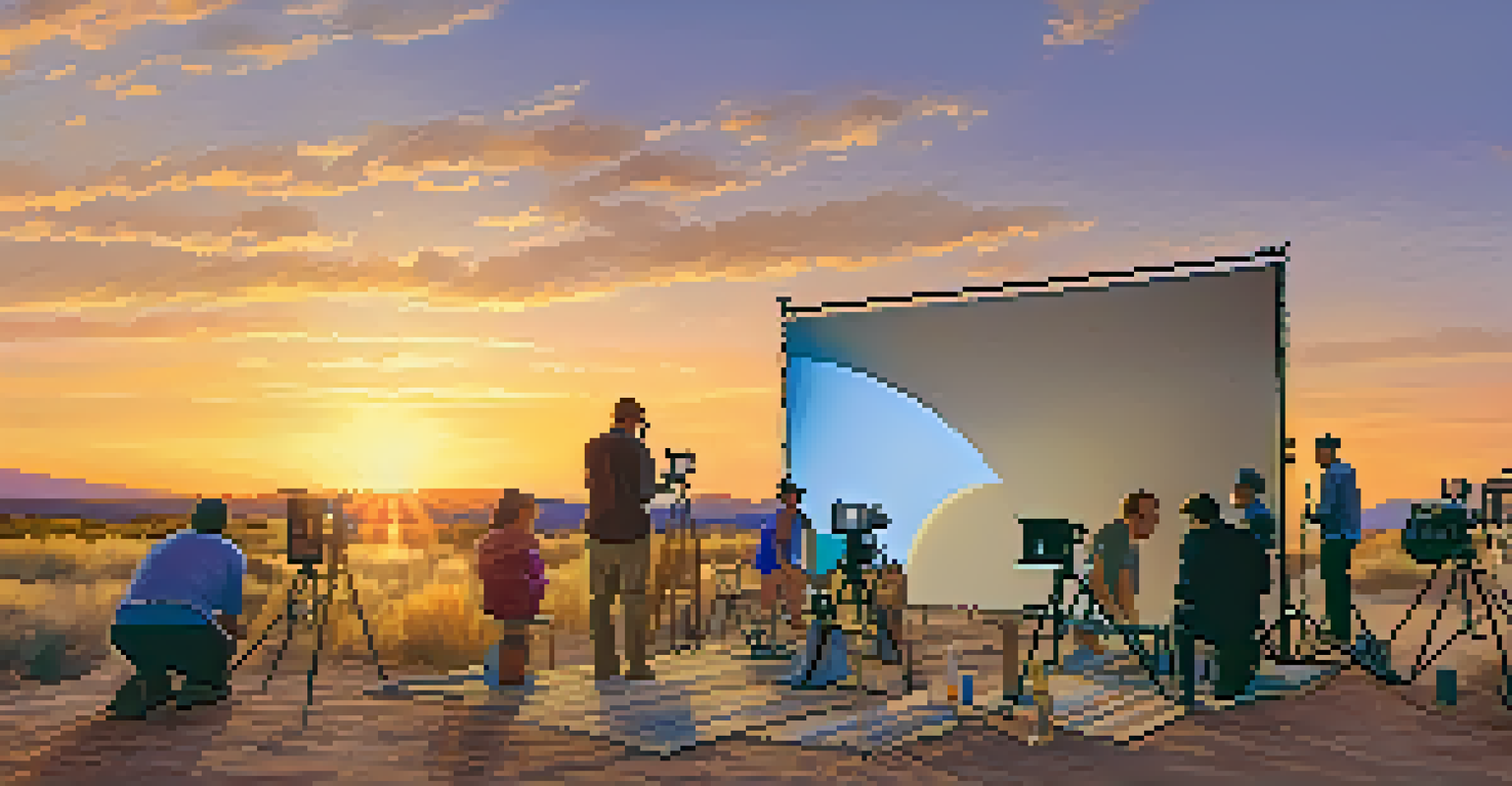Understanding Film Budgets: Key Components and Considerations

What is a Film Budget and Why Does It Matter?
A film budget is essentially a detailed financial plan that outlines the estimated costs of producing a film. It serves as the backbone of any film project, guiding decisions from pre-production through post-production. Without a well-structured budget, a film's production can quickly spiral out of control, risking both the project's completion and the financial investment.
A budget is telling your money where to go instead of wondering where it went.
Understanding the budget is crucial not just for filmmakers, but also for investors and studios. It reflects the scope and ambition of the project, helping stakeholders gauge potential profitability. In short, a film budget is more than just numbers; it’s a roadmap to success in a complex industry.
Furthermore, budgets can vary dramatically based on the type of film being made. Independent films often operate on shoestring budgets, while blockbuster productions may have millions at their disposal. This variation highlights the importance of tailoring a budget to match the film's vision and market expectations.
Key Components of a Film Budget Explained
A film budget typically includes several key components, starting with pre-production costs. This phase covers expenses like script development, casting, and location scouting. Each of these elements plays a critical role in setting the stage for a successful shoot, making it essential to allocate enough funds here.

Next come production costs, which encompass everything that happens during filming. This includes crew salaries, equipment rentals, set construction, and more. Keeping a close eye on production expenses is vital, as this is where the bulk of the budget is often spent, and unforeseen issues can arise.
Film Budget: A Critical Blueprint
A film budget serves as a detailed financial plan crucial for guiding a project from pre-production to post-production.
Finally, there are post-production costs, which cover editing, sound design, and visual effects. This stage can sometimes be underestimated but can significantly impact the final quality of the film. A well-rounded budget will take into consideration each of these components to ensure a cohesive funding strategy.
The Importance of Contingency Funds
In the world of film production, surprises are par for the course. That's why including a contingency fund in your budget is crucial. Typically, this fund is around 10-20% of the total budget and acts as a safety net for unexpected costs that may arise during production.
Good budgeting is about understanding your goals, priorities, and making sure your spending aligns with them.
Without a contingency fund, filmmakers may find themselves in a tight spot if, for instance, an actor needs to be replaced or if a location is suddenly unavailable. These situations can quickly lead to increased costs and delays, jeopardizing the entire project. Having that buffer allows for greater flexibility and peace of mind.
Ultimately, a well-planned contingency can save filmmakers from financial disaster. It demonstrates foresight and professionalism, reassuring investors that the project is in capable hands. This kind of planning can make all the difference when navigating the unpredictable nature of film production.
Labor Costs: The Heart of Your Budget
Labor costs are often the largest portion of a film budget, making them a critical area to address. This includes salaries for directors, actors, crew members, and any other personnel involved in the production. A well-paid cast and crew can lead to a more efficient and high-quality production.
However, it’s essential to balance these costs with budget constraints. Filmmakers must determine the right talent for the project without overspending, which can be a challenging task. Sometimes, casting lesser-known actors can save money while still achieving impressive performances.
Labor and Location Costs Matter
Labor and location costs are significant factors in a film budget that require careful planning to balance quality and expenses.
Additionally, labor costs also extend to union regulations and benefits, which need to be factored into the budget. Understanding these aspects ensures compliance with industry standards, which not only protects the project legally but also fosters a positive working environment.
Location Costs: Choosing the Right Setting
Location costs are another significant factor to consider in a film budget. Filmmakers must decide whether to shoot on location or on a soundstage, each option carrying its own set of expenses. While shooting on location can lend authenticity to a film, it can also introduce costs related to permits, travel, and accommodations.
Choosing the right setting can also enhance the story being told, making the budgetary investment worthwhile. Filmmakers should carefully weigh the benefits of each location against the associated costs to ensure the best use of their resources. Sometimes, a creative compromise, like using a nearby area that resembles the desired location, can save money.
Ultimately, careful planning and negotiation with location owners or municipalities can help keep costs down. By considering all aspects of location expenses, filmmakers can create a visually stunning film without breaking the bank.
Marketing and Distribution: Budgeting for Success
Once filming is complete, the next phase is marketing and distribution, which is often overlooked during the budgeting process. Allocating funds for this stage is crucial, as a great film can go unnoticed without effective promotion. Marketing costs may include trailers, posters, and advertising campaigns to generate buzz.
Additionally, distribution expenses can involve festival entry fees, shipping prints, and securing a distributor. Filmmakers must ensure that their budget accounts for both marketing and distribution to maximize audience reach and potential revenue. A comprehensive marketing strategy can significantly impact a film's box office performance.
Marketing is Key to Success
Allocating funds for marketing and distribution is essential, as even a great film can go unnoticed without effective promotion.
Finally, understanding the target audience and tailoring marketing efforts accordingly can lead to more successful outreach. This proactive approach not only helps in recouping production costs but can also pave the way for future projects.
Final Thoughts: The Art of Budgeting in Film
Film budgeting is a vital skill that combines artistry with practicality. It requires a clear vision of the project, an understanding of the market, and the ability to adapt to changing circumstances. By breaking down the budget into its key components, filmmakers can navigate the complexities of production more effectively.
Moreover, successful budgeting can build trust with investors and stakeholders, showcasing professionalism and strategic planning. It’s not just about keeping costs in check; it’s about fostering creativity within financial constraints, allowing filmmakers to bring their visions to life.

In conclusion, mastering the art of film budgeting is an essential step towards creating a successful film. With careful planning, foresight, and flexibility, filmmakers can turn their creative dreams into reality while ensuring a stable financial foundation.